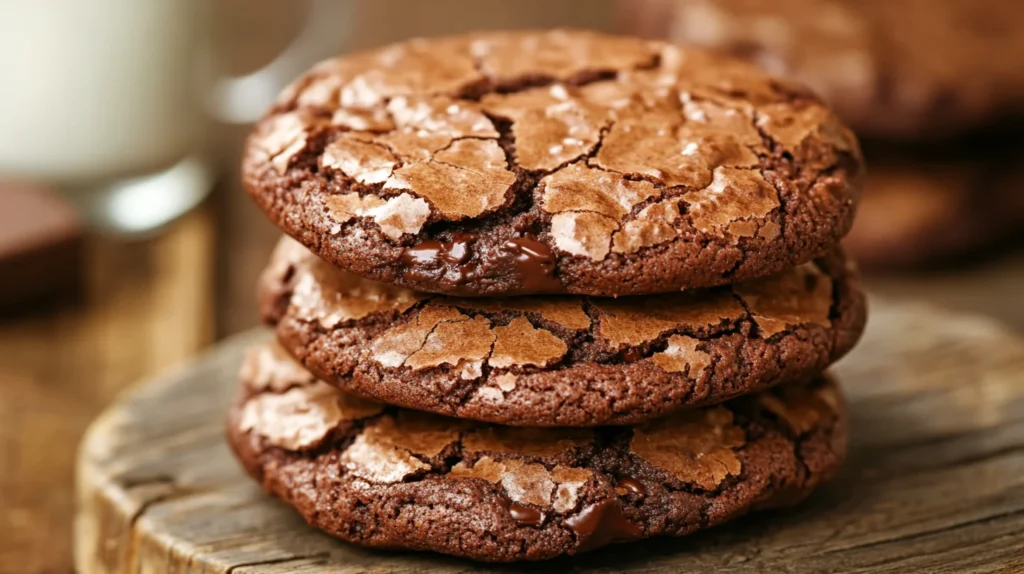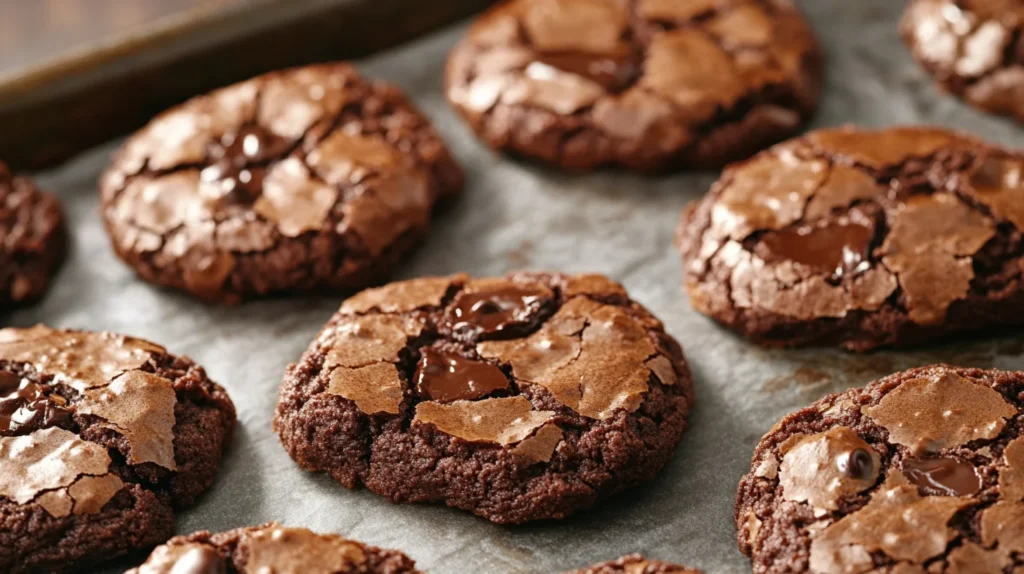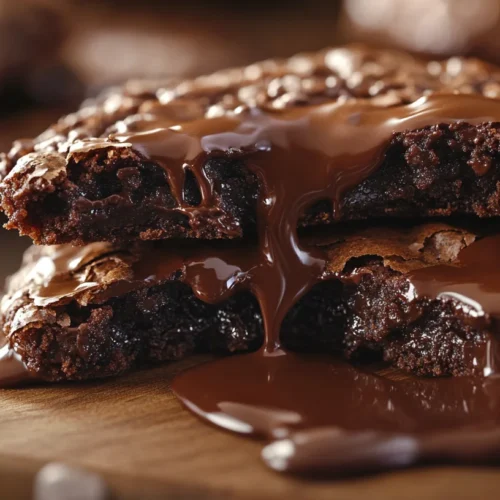Brownie cookies are a mouthwatering combination of two beloved treats: the fudgy richness of brownies and the chewy texture of cookies. These hybrid delights have gained immense popularity among dessert lovers for their indulgent flavor, versatility, and ease of preparation. Whether you’re a fan of gooey chocolate or prefer a crispier edge, brownie cookies offer the best of both worlds. In this article, we’ll explore the origins of these delectable cookies, their key ingredients, step-by-step recipes, and creative variations that cater to all taste preferences.

The Origin of Brownie Cookies
Brownie cookies emerged as a delightful innovation in the world of baking, combining the decadence of brownies with the portability and ease of cookies. This hybrid dessert captures the fudgy interior of brownies while delivering the crisp exterior of cookies, making it a favorite for chocolate lovers everywhere. While the exact origin is unclear, their rise in popularity can be linked to the culinary trend of fusing classic recipes to create new experiences. Brownie cookies have become a staple in bakeries and home kitchens, appealing to those who crave indulgence in a convenient form.
Looking for more creative cookie ideas? Check out these Lemon Cookies: A Sweet and Zesty Delight. They’re perfect if you’re craving something a little lighter but just as satisfying.
Key Ingredients for Brownie Cookies
Every great recipe starts with high-quality ingredients, and brownie cookies are no exception. Their distinctive texture and rich flavor depend on carefully chosen components.
Core Ingredients
The foundation of brownie cookies lies in these essential ingredients:
- Chocolate: High-quality chocolate, whether dark or semi-sweet, provides the rich and intense flavor. Melted chocolate often forms the base, while chocolate chips may be added for extra texture.
- Butter: Unsalted butter contributes to the moist, tender texture and adds a creamy richness.
- Sugar: A combination of granulated and brown sugar is common. Granulated sugar helps achieve a crisp exterior, while brown sugar adds moisture and a slight caramel undertone.
- Eggs: Eggs act as a binding agent, creating the chewy consistency that distinguishes brownie cookies.
- Flour: All-purpose flour provides structure. The quantity is typically less than standard cookie recipes, ensuring a softer, fudgier result.
- Vanilla Extract: A splash of vanilla enhances the overall flavor, rounding out the sweetness of the chocolate.
Optional Add-ins
To elevate the recipe, bakers often incorporate additional ingredients:
- Nuts: Walnuts, pecans, or almonds add a pleasant crunch.
- Chocolate Chips: Semi-sweet, milk, or white chocolate chips boost the decadence factor.
- Sea Salt: A sprinkle of sea salt on top creates a delightful contrast to the sweetness, enhancing the chocolatey depth.
- Espresso Powder: A small amount intensifies the chocolate flavor without overpowering the overall taste.
Step-by-Step Recipe for Perfect Brownie Cookies
Making brownie cookies is a straightforward process that combines the techniques of both cookie and brownie preparation. By following these detailed steps, you’ll achieve the ideal texture and flavor every time.
Preparing the Batter
- Melt the Chocolate and Butter: Begin by melting high-quality chocolate and unsalted butter together. This can be done using a double boiler or in the microwave in short, 20-second bursts, stirring in between. The result should be a smooth, glossy mixture. Let it cool slightly before proceeding.
- Combine the Sugars: In a separate bowl, mix granulated sugar and brown sugar. The combination of these sugars creates a balanced sweetness and contributes to the chewy texture.
- Whisk the Eggs and Vanilla: Add eggs and vanilla extract to the sugar mixture. Use a whisk or an electric mixer to beat the ingredients until they become light and fluffy. This step helps incorporate air, giving the cookies a slightly lifted texture.
- Blend the Wet Ingredients: Slowly pour the melted chocolate and butter mixture into the egg-sugar mixture, stirring until well combined.
- Sift the Dry Ingredients: In another bowl, sift together all-purpose flour, cocoa powder, baking powder, and a pinch of salt. Sifting ensures there are no lumps and results in a smoother batter.
- Combine Wet and Dry Mixtures: Gradually fold the dry ingredients into the wet mixture using a spatula. Be careful not to overmix, as this can affect the cookies’ texture.
Shaping and Baking
- Preheat the Oven: Set your oven to 350°F (175°C) and line baking sheets with parchment paper to prevent sticking.
- Portion the Dough: Use a cookie scoop or tablespoon to drop evenly sized dollops of dough onto the prepared baking sheets. Leave adequate space between each to allow for spreading during baking.
- Bake to Perfection: Bake the cookies for 8–10 minutes. Keep a close eye on them; they should appear slightly underbaked in the center when you take them out. This ensures the fudgy texture.
- Cool on the Baking Sheet: Allow the cookies to cool on the baking sheet for 5 minutes before transferring them to a wire rack. This step helps them set without overcooking.
Cooling and Storing
- Complete Cooling: Once on the wire rack, let the cookies cool completely. This prevents them from breaking apart and allows the flavors to develop.
- Store Properly: To maintain freshness, store the cookies in an airtight container at room temperature for up to 5 days. For longer storage, freeze the cookies in a resealable plastic bag, separating layers with parchment paper.
For other versatile recipes, check out how to make a comforting Tini Mac and Cheese. It’s an easy, creamy dish that pairs well with these cookies for a sweet and savory meal.
Tips for Achieving the Best Brownie Cookies
Perfecting brownie cookies requires a mix of precise technique and attention to detail. These tips will ensure that your cookies turn out irresistibly delicious every time.
Balancing Fudgy and Chewy Textures
- Adjust Baking Time: For a fudgier texture, slightly underbake the cookies. Remove them from the oven as soon as the edges are set and the centers look slightly soft. If you prefer a chewier consistency, bake them for an additional 1–2 minutes, being careful not to overbake.
- Use the Right Flour Ratio: A smaller proportion of flour keeps the cookies tender and prevents a cakey texture. Always measure accurately, preferably using a kitchen scale.
- Incorporate Brown Sugar: The higher moisture content in brown sugar enhances the chewiness and adds a subtle caramel flavor.
Avoiding Common Mistakes
- Don’t Overmix the Batter: Mixing too much can develop gluten in the flour, resulting in tough cookies. Fold the ingredients gently until just combined.
- Mind the Chocolate Temperature: Ensure the melted chocolate mixture is slightly cooled before adding it to the eggs and sugar. If it’s too hot, it may cook the eggs or create an inconsistent batter.
- Avoid Overcrowding the Baking Sheet: Give each cookie enough space to spread evenly. Overcrowding can cause uneven baking or merging of cookies.
Variations on the Classic Recipe
Experimenting with variations allows you to customize brownie cookies to suit your taste preferences. Here are some creative twists to try:

Peanut Butter Brownie Cookies
- Flavor Combination: Swirl creamy or chunky peanut butter into the batter before baking for a nutty contrast to the rich chocolate.
- Add Peanut Butter Chips: Enhance the flavor with peanut butter chips or chopped peanuts for extra texture.
- Presentation: Drizzle melted peanut butter over the cooled cookies for an elegant finish.
Double Chocolate Brownie Cookies
- Boost Chocolate Intensity: Incorporate cocoa powder into the dry ingredients for an even deeper chocolate flavor.
- Add Chocolate Chunks: Mix in semi-sweet or dark chocolate chunks for gooey pockets of melted chocolate in every bite.
- Finish with Sea Salt: Sprinkle flaky sea salt on top before baking to balance the sweetness and elevate the flavor profile.
Vegan and Gluten-Free Options
- Vegan Brownie Cookies: Replace eggs with flaxseed meal or chia seeds mixed with water, and use plant-based butter and dairy-free chocolate.
- Gluten-Free Brownie Cookies: Substitute all-purpose flour with a gluten-free flour blend designed for baking. Almond flour can also work, though it may slightly alter the texture.
- Ensure Quality: Choose high-quality vegan and gluten-free ingredients to maintain the cookies’ rich, indulgent taste.
Pairing Brownie Cookies with Beverages
Brownie cookies are a versatile dessert that pairs beautifully with a variety of beverages. Whether you’re indulging in a cozy evening treat or serving them at a party, these pairings can enhance the experience.
Brownie cookies pair beautifully with a variety of dishes. For a creamy companion, try serving them alongside a slice of Cherry Cheesecake. The tart cherry topping perfectly balances the richness of the cookies.

Milk for Classic Comfort
- Why Milk Works: The creamy and neutral flavor of milk complements the rich, chocolatey taste of brownie cookies. The cold, refreshing texture balances the fudgy sweetness, making it a timeless combination.
- Variations: For added indulgence, try serving the cookies with chocolate milk or a splash of flavored syrups like vanilla or caramel in your glass of milk.
- Kid-Friendly Option: Pairing brownie cookies with milk is a hit among kids, making it an excellent choice for birthday parties or casual gatherings.
Gourmet Pairings
- Coffee: The bold, slightly bitter flavor of coffee enhances the richness of brownie cookies. Pair them with an espresso, cappuccino, or a café mocha for a sophisticated twist.
- Hot Chocolate: Double the chocolate indulgence by serving brownie cookies with a cup of creamy hot chocolate topped with whipped cream or marshmallows.
- Tea: For a lighter pairing, opt for teas like Earl Grey or chai, whose aromatic flavors contrast the sweetness of the cookies.
- Wine: For adult gatherings, consider pairing brownie cookies with a dessert wine such as Port or a red wine like Merlot, which complements the chocolatey notes.
Healthier Alternatives for Brownie Cookies
If you’re looking to enjoy brownie cookies while maintaining a healthier lifestyle, there are several ways to lighten up the recipe without sacrificing flavor.
Reducing Sugar
- Cut Down on Granulated Sugar: Replace some of the granulated sugar with natural sweeteners like coconut sugar, maple syrup, or honey for a less processed option.
- Use Dark Chocolate: Choose dark chocolate with a higher cocoa content (70% or more). It has less sugar compared to milk chocolate and adds a more intense chocolate flavor.
Substituting Fats
- Swap Butter for Avocado: Pureed avocado works as a healthy fat alternative, providing a creamy texture and subtle flavor.
- Use Greek Yogurt: Greek yogurt can replace part of the butter, adding moisture while reducing fat content.
- Opt for Coconut Oil: Coconut oil is another substitute for butter that adds a slight tropical flavor and healthy fats.
Adding Nutrients
- Incorporate Whole Grains: Swap a portion of all-purpose flour with whole wheat flour or oat flour for added fiber.
- Add Seeds: Mix in chia seeds, flaxseeds, or sunflower seeds for a boost of protein and omega-3 fatty acids.
- Include Fruits: Fold in dried fruits like cranberries, cherries, or raisins for natural sweetness and chewy texture.
Frequently Asked Questions
Why Are My Brownie Cookies Flat?
Flat brownie cookies often result from one or more of the following issues:
- Overmixing the Batter: Overmixing can incorporate excess air into the batter, which deflates during baking, causing the cookies to spread too much.
- Too Much Butter or Chocolate: An imbalance of fat in the recipe can make the dough too loose, resulting in flat cookies.
- Insufficient Chilling: If the dough isn’t chilled before baking, it may spread excessively in the oven. Chilling firms up the fat and allows the cookies to retain their shape.
- Oven Temperature: If the oven is too hot, the cookies can spread before the edges set, leading to a flat appearance. Use an oven thermometer to ensure accurate temperature.
What Are the Three Types of Brownies?
Brownies can be categorized based on their texture and consistency:
- Fudgy Brownies: These are dense, moist, and rich, with a gooey center. They contain a higher ratio of fat (like butter or chocolate) to flour.
- Chewy Brownies: These have a bit more structure but still retain moisture. The balance of sugar, eggs, and flour gives them their characteristic chewiness.
- Cakey Brownies: These are light and airy, with a texture resembling cake. They contain more flour and leavening agents, such as baking powder, to create a fluffier consistency.
What Can I Add to Brownie Mix to Make It Taste Better?
Enhance the flavor and texture of store-bought brownie mix with these additions:
- Flavor Boosters: Add a teaspoon of vanilla extract, espresso powder, or a pinch of cinnamon to deepen the flavor.
- Mix-ins: Stir in chocolate chips, nuts (like walnuts or pecans), or dried fruits for added texture and flavor.
- Swirls: Create swirls of peanut butter, cream cheese, or Nutella on top for a gourmet touch.
- Salt: Sprinkle a pinch of flaky sea salt on top after baking to contrast the sweetness and enhance the chocolate flavor.
- Milk or Butter Substitute: Replace the water in the mix with milk or melted butter for a richer and more homemade taste.
Why Is a Brownie Classified as a Cookie Rather Than a Cake?
Brownies are generally classified as a type of cookie, specifically a bar cookie, rather than a cake for the following reasons:
- Baking Method: Brownies are typically baked in a flat pan, similar to bar cookies, and are cut into squares or rectangles, unlike cakes, which are baked in round or layered pans.
- Texture: Brownies have a denser texture, more akin to a cookie or fudge, while cakes are light and fluffy due to higher amounts of leavening agents.
- Ingredient Ratios: Brownies contain less flour and more fat compared to cakes, resulting in a fudgier consistency.
This classification reflects the culinary technique and characteristics that brownies share with cookies rather than cakes.
Conclusion
Brownie cookies are the ultimate indulgence for chocolate lovers, combining the best features of brownies and cookies into one irresistible treat. Their rich, fudgy centers and slightly crisp edges make them a versatile dessert that can be customized to suit any taste or occasion. From experimenting with add-ins like peanut butter or nuts to creating healthier versions with whole grains and reduced sugar, the possibilities are endless. Whether you pair them with a classic glass of milk, a cup of coffee, or enjoy them on their own, brownie cookies are a guaranteed crowd-pleaser. So why wait? Gather your ingredients, follow the steps, and enjoy the delicious results of baking your own batch of brownie cookies today!

Brownie Cookies – Chewy, Fudgy & Irresistible Chocolate Delight
Equipment
- ✔ Mixing bowls (one for dry ingredients, one for wet)
- ✔ Hand mixer or stand mixer
- ✔ Whisk & rubber spatula
- ✔ Baking sheet
- ✔ Parchment paper or silicone baking mat
- ✔ Cookie scoop (optional, for even portions)
- ✔ Wire cooling rack
Ingredients
- Dry Ingredients:
- 1 cup 125g all-purpose flour
- ¼ cup 25g unsweetened cocoa powder
- 1 teaspoon baking powder
- ½ teaspoon salt
- Wet Ingredients:
- ½ cup 1 stick unsalted butter
- 1 ½ cups 270g semi-sweet chocolate chips or chopped chocolate
- ¾ cup 150g granulated sugar
- ½ cup 100g brown sugar
- 2 large eggs
- 1 teaspoon vanilla extract
- Optional Mix-ins:
- ½ cup chocolate chips for extra gooeyness
- ½ cup chopped walnuts or pecans for a crunchy texture
- ½ teaspoon espresso powder enhances chocolate flavor
Instructions
- Step 1: Preheat the Oven & Prepare Baking Sheets
- Preheat your oven to 350°F (175°C).
- Line a baking sheet with parchment paper or a silicone mat.
- Step 2: Melt the Chocolate & Butter
- In a heatproof bowl, melt butter and semi-sweet chocolate over a double boiler (or microwave in 20-second intervals, stirring in between).
- Stir until smooth and glossy. Let cool slightly.
- Step 3: Mix the Wet Ingredients
- In a large mixing bowl, beat eggs, granulated sugar, and brown sugar together until light and fluffy (about 2 minutes).
- Add vanilla extract and melted chocolate mixture, then mix until combined.
- Step 4: Sift & Add Dry Ingredients
- In another bowl, sift together flour, cocoa powder, baking powder, and salt.
- Gradually add the dry ingredients to the wet mixture, stirring until just combined.
- Fold in extra chocolate chips or nuts, if using.
- Step 5: Scoop & Bake the Cookies
- Use a cookie scoop or tablespoon to drop batter onto the lined baking sheet (about 2 inches apart).
- Bake for 10-12 minutes, until the cookies have crackly tops but soft centers.
- Step 6: Cool & Enjoy
- Let cookies cool on the baking sheet for 5 minutes, then transfer to a wire rack to cool completely.
- Enjoy warm or store for later!
Notes
✔ Make-Ahead Tip: Chill the dough for 30 minutes for thicker cookies.
✔ Storage: Keep cookies in an airtight container at room temperature for 3-4 days.
✔ Freezing: Freeze cookie dough balls for up to 3 months; bake from frozen, adding 1-2 extra minutes.

